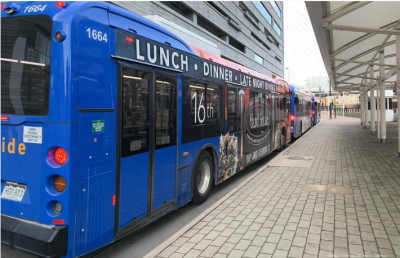Why every business owner should be worried about RTD’s crisis
Whenever Denver is pitched to companies looking to relocate, its transit system is cited as a major selling factor.
“Metro Denver is a model for the country when it comes to solving transportation challenges, taking steps to reduce sprawl, and create new neighborhoods along transit,” touts the Metro Denver Economic Development Commission’s website.
Proximity to transit has influenced tech companies, professional offices and even major headquarters that are flocking to Lower Downtown, the Central Business District and the Denver Tech Center.
Development projects tied to transit have popped up across the metro, as clusters of office, retail and residential projects — think South Broadway, River North, Lone Tree and Pena Station Next — seek the convenience of rail access. The Regional Transportation District’s free shuttle along the 16th Street Mall moves thousands of tourists, shoppers and workers daily, as does the free MetroRide, which operates during peak commute hours.
Yet despite its important role in the economic growth of the region, RTD has been plagued with budget problems and staffing challenges arising out of high driver turnover. These headaches have resulted in numerous delays and no-shows, causing inconvenience and annoyance to riders. Employers may have noticed employees arriving to work later, sharing water-cooler grumbles about crowds at bus and train stops, and dealing with parking challenges as their vehicles once again become more attractive than standing at a freezing transit station.
On Dec. 12, the transit agency will announce “temporary” service cutbacks in an attempt to reduce driver overtime and bring more certainty to the routes that remain in place. Whatever cuts are made, RTD’s current condition should provide a wake-up call to the business community on multiple fronts:
- Frustrating commutes can jeopardize workplace culture, work-life balance and employee retention. Unpredictable travel times and the resulting irregular work schedules can also impact productivity — and eventually revenue.
- Developers should be concerned about marketing their multimillion-dollar, transit-oriented projects if routes are cut back or canceled. And this trickles down to related retail, residential and office tenants looking at these new projects.
- A decrease in transit volume means an increase in vehicular traffic, leading to even more congestion within an already-burdened infrastructure — not to mention the increased environmental impact.
- Finally, every business in the metro should be concerned about the long-term effects that RTD’s instability could have on overall growth of the region.
So what can businesses do? Listen to employees and learn how RTD’s cutbacks are impacting them. Consider flexible work schedules to accommodate shifting commute times. Speak out about route cutbacks and the importance of transit to business as RTD continues to develop a plan for greater efficiencies.
And here’s a radical suggestion: Don’t stop using RTD. Encourage employees to keep using it. If you aren’t already offering EcoPass perks to staff, consider adding them. As Ed Sealover’s recent in-depth story noted, RTD ridership has declined continuously for five years, falling from 103.4 million passengers in the 12 months that began in December 2014 to 97.6 million in 2018. Through September 2019, year-to-date ridership is down another 0.7% throughout the system and 3.7% specifically on its eight light-rail lines.
As important as a healthy, well-run transit system is to Denver, we can’t afford to see such a valuable asset diminished. The business community has a strong collective voice; now’s the time to use it.
Meanwhile, I hope to see you on the bus.
![DRMAClogo[1] DRMAC](https://drmac-co.org/wp-content/uploads/2019/12/DRMAC20logo1.jpg)



